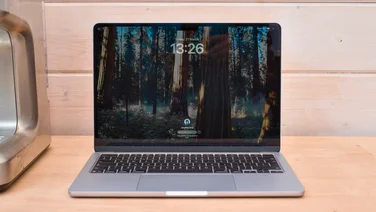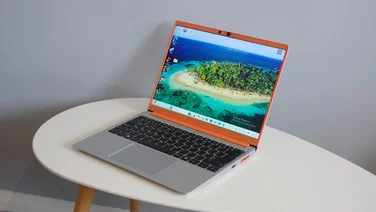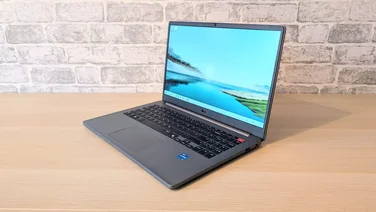To help us provide you with free impartial advice, we may earn a commission if you buy through links on our site. Learn more
- Asus Vivobook 13 Slate OLED review: What you need to know
- Asus Vivobook 13 Slate OLED review: Price and competition
- Asus Vivobook 13 Slate OLED review: Design and key features
- Asus Vivobook 13 Slate OLED review: Display
- Asus Vivobook 13 Slate OLED review: Performance
- Asus Vivobook 13 Slate OLED review: Verdict










- Glorious 13.3in OLED screen
- Keyboard and stylus included in the box
- Reasonable price
- Slow CPU
- Sluggish eMMC storage
- Mediocre battery life
There was a time, not that long ago, when 2-in-1 laptops with OLED displays were both stupidly expensive and, thanks to the risk of screen burn-in and poor battery life, not a particularly practical proposition, either. With the onward march of technology, however, that’s no longer the case and, as the Asus Vivobook 13 Slate OLED proves, some manufacturers are even beginning to introduce the tech to their budget ranges as well.
If you use your laptop mainly for watching Netflix, Amazon Prime or Disney Plus but don’t want to spend a fortune, this 2-in-1 detachable could be the one for you. It isn’t the fastest laptop on the planet but the display is amazingly good for such a cheap machine.
READ NEXT: These are the best laptops you can buy right now
Asus Vivobook 13 Slate OLED review: What you need to know
The Vivobook Slate 13’s biggest claim to fame is that it comes with a 13.3in OLED screen and costs £550. However, there’s a bit more to it than just that. For the money, it also comes bundled with an active stylus and, unlike rivals from Microsoft and Apple, the detachable keyboard is included in the box.
Where it doesn’t look quite so impressive is in the core specification. Instead of being powered by an Intel Core i3 or AMD Ryzen 5 CPU, the Slate 13 OLED has a quad-core Intel Pentium Silver N6000 at its heart, backed by a mere 4GB of RAM and 128GB of eMMC storage. This is not a laptop that will cope well with a heavy workload, that’s for sure.










Asus Vivobook 13 Slate OLED review: Price and competition
It doesn’t take much to figure out where the Vivobook’s main competitor lies; the only serious 2-in-1 competition in this price bracket is the Microsoft Surface Go 3.
The Surface Go 3 can be had for the same amount with a Type Cover keyboard and stylus. It has a smaller 10.4in IPS display, however, and a weedier, dual-core Intel Pentium Gold 6500Y CPU.
If you’re willing to purchase a non-Windows machine, then the Apple iPad makes a decent alternative. It costs around £550 to build a similar bundle with the tablet, Smart Keyboard and Apple Pencil. It, too, has a smaller 10.2in non-OLED display, but it’s a faster, more responsive machine.
If it’s definitely an OLED screen that you want, then the Samsung Galaxy Tab S7 Plus is another option. It has a 12.4in display, a far sleeker design and runs Android, but is more expensive to buy. With its keyboard case and the bundled stylus you’re going to be paying around £670 all in.
If, on the other hand, you’re willing to forgo the 2-in-1 detachable design for a more practical clamshell laptop, there’s a whole world more choice, including the lovely Microsoft Surface Laptop Go. This is a mere £559 at the time of writing and comes with a far more capable specification (Core i5, 8GB of RAM and a quicker 128GB SSD). Again, however, OLED is nowhere to be found here.
Asus Vivobook 13 Slate OLED review: Design and key features
Despite the low price, the design of the Vivobook and its keyboard cover isn’t bad at all. It isn’t the slimmest, sleekest thing in the world but the tablet on its own weighs a mere 785g (it’s 8.3mm thick) and, once you’ve added the keyboard cover and the rear kickstand, this rises to 1.39kg and 18mm. At this price, it’s actually pretty portable.
Practically, I do have a few reservations about the design. The first concerns the kickstand, which clamps magnetically to the rear of the tablet, allowing you to prop it up on a surface or your lap. It does the job and the hinge is nice and stiff so it doesn’t wobble or sag, but I found I’d often dislodge the cover as I attempted to adjust the angle. It isn’t as elegant or as easy to use as the built-in kickstand on the Surface Go 3.
The physical connectivity isn’t particularly generous, either, although that isn’t particularly surprising in this type of product. On the left edge of the tablet is a pair of USB-C 3.1 ports and a microSD card slot alongside a 3.5mm headphone jack, and that’s your lot. And although it is brilliant that you get a pressure-sensitive stylus included for the money, it’s a mite disappointing that there’s nowhere in the body of the tablet to slot it. Instead, Asus provides a fabric loop that attaches via magnets to the tablet’s rear right side.










Aside from these gripes, however, there isn’t a huge amount to complain about. There are a few strange layout choices on the keyboard, such as the half-height Enter key and the fact that there’s a hash key sitting just above it – I found that this often led to me inadvertently appending a “#” to the end of some passwords and sentences.
Overall, however, it’s a pleasant enough thing to type on with just enough feedback and travel that it’s easy to get up to speed without too much readjustment. The click on the touchpad feels a bit clunky, but the smooth surface makes pointing, scrolling and zooming a mercifully stress-free experience.
More impressive, however, is that the tablet comes with a decent 1080p webcam that captures crisp video and a quad speaker system that’s superb for everyday calling and podcast listening. That stylus works nicely, too, and has 4,096 levels of pressure sensitivity plus a 266Hz sampling rate to ensure there’s barely any lag. Finally, there’s also a 13MP camera on the rear of the tablet, but I can’t see many people preferring that to the camera in their phone.
READ NEXT: The best laptop deals of the month
Asus Vivobook 13 Slate OLED review: Display
This laptop is all about its display, however, and first impressions of the 13in 1080p panel on the Vivobook Slate 13 are very good. As you’d expect from an OLED screen, the colours are vibrant and the contrast essentially perfect, with colours popping off the screen to great effect.
I fired up the final episode of series 6 of The Expanse and the dramatic space battle scenes looked fabulous on the Vivobook’s display, the pin pricks of the stars and the neon lights of the ship interiors standing out beautifully against the inky darkness of space. Just make sure you don’t enable Windows 11’s HDR settings, as this robs colours of their vibrancy.










Even under testing, it’s a good performer. For starters, it’s capable of representing a huge 116% of the P3 colour space and colour accuracy is pretty good, too, with an average Delta E colour variance score of 1.05.
In short, it’s miles better than a display on a £550 laptop has any right to be. However, it does have one major weakness: the glossy finish is far too reflective and it makes working outside or next to a bright window uncomfortable. That’s a shame, as the peak brightness of 359cd/m² is absolutely fine for most indoor situations.
Asus Vivobook 13 Slate OLED review: Performance
The Slate 13’s biggest issue isn’t its reflective display, however, but its core specification. Inside, it’s powered by a Pentium Silver N6000, which is a CPU designed for budget laptops and Chromebooks. This is backed up by just 4GB of RAM and 128GB of slow eMMC storage, a combination that – unsurprisingly – delivers an uninspiring set of benchmark results.



With such a weak specification, it doesn’t take an awful lot to slow the Vivobook 13 Slate OLED down to a grinding halt, and you’re never going to do much gaming on it, either. However, as long as you’re careful with the number of apps you have running simultaneously and you keep your browser tabs and extensions under control, it’s usable enough.
There isn’t much you can do about the mediocre battery life, however. It lasted only 7hrs 8mins in our video rundown test, which is at the lower end of what we’d be happy with these days.

Asus Vivobook 13 Slate OLED review: Verdict
The question you need to ask yourself with the Asus Vivobook 13 Slate OLED is: are you willing to compromise on performance and battery life in order to bag yourself a stunning OLED display?
If your answer is yes and you don’t see yourself doing anything more demanding than browsing the web, writing emails and documents and watching Netflix, then I suspect you’d be quite pleased with it. For watching TV shows and movies on the go – if you can find a spot away from bright lights – it’s absolutely brilliant.
If, on the other hand, you value not having to constantly monitor the number of apps you’re running and the browser tabs you have open, then it’s well worth looking for something with a bit more grunt such as the Microsoft Surface Laptop Go or Apple iPad.


















